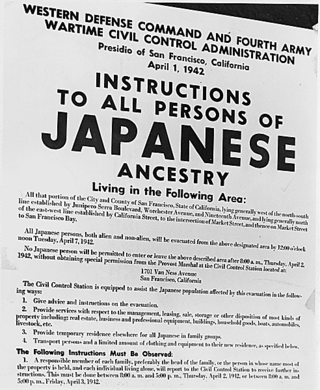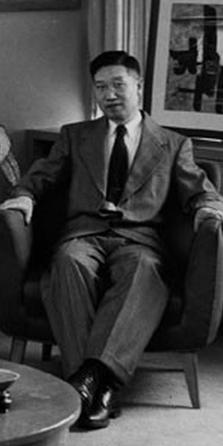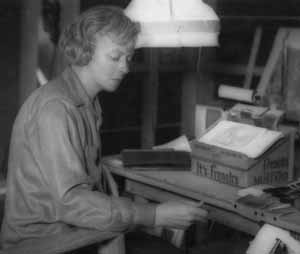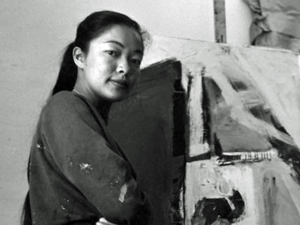Related Research Articles
Sansei is a Japanese and North American English term used in parts of the world to refer to the children of children born to ethnically Japanese emigrants (Issei) in a new country of residence, outside of Japan. The nisei are considered the second generation, while grandchildren of the Japanese-born emigrants are called Sansei. The fourth generation is referred to as yonsei. The children of at least one nisei parent are called Sansei; they are usually the first generation of whom a high percentage are mixed-race, given that their parents were (usually), themselves, born and raised in America.

Japantown, commonly known as J Town, is a historic cultural district of San Jose, California, north of Downtown San Jose. Historically a center for San Jose's Japanese American and Chinese American communities, San Jose's Japantown is one of only three Japantowns that still exist in the United States, alongside San Francisco's Japantown and Los Angeles's Little Tokyo.

Yuri Kochiyama was an American civil rights activist. Influenced by her Japanese-American family's experience in an American internment camp, her association with Malcolm X, and her Maoist and Islamic beliefs, she advocated for many causes, including black separatism, the anti-war movement, reparations for Japanese-American internees, and the rights of political prisoners.
Masumi Hayashi was an American photographer and artist who taught art at Cleveland State University, in Cleveland, Ohio, for 24 years. She won a Cleveland Arts Prize; three Ohio Arts Council awards; a Fulbright fellowship; awards from National Endowment for the Arts, Arts Midwest, and Florida Arts Council; as well as a 1997 Civil Liberties Educational Fund research grant.

Chiura Obata was a well-known Japanese-American artist and popular art teacher. A self-described "roughneck", Obata went to the United States in 1903, at age 17. After initially working as an illustrator and commercial decorator, he had a successful career as a painter, following a 1927 summer spent in the Sierra Nevada, and was a faculty member in the Art Department at the University of California, Berkeley, from 1932 to 1954, interrupted by World War II, when he spent a year in an internment camp. He nevertheless emerged as a leading figure in the Northern California art scene and as an influential educator, teaching at the University of California, Berkeley, for nearly twenty years and acting as founding director of the art school at the Topaz internment camp. After his retirement, he continued to paint and to lead group tours to Japan to see gardens and art.
Nisei is a Japanese-language term used in countries in North America and South America to specify the ethnically Japanese children born in the new country to Japanese-born immigrants. The Nisei are considered the second generation and the grandchildren of the Japanese-born immigrants are called Sansei, or third generation. Though nisei means "second-generation immigrant", it often refers to the children of the initial diaspora, occurring in the late 19th and early 20th centuries, and overlapping with the G.I. and silent generations.
Thomas Yamamoto was an American artist.
Soji Kashiwagi is a Sansei journalist, playwright and producer. He is the Executive Producer for the Grateful Crane Ensemble theatre company in Los Angeles. He has contributed to The Rafu Shimpo with his column, "Corner Store." He is the son of Nisei playwright Hiroshi Kashiwagi.

Patti Jo "PJ" Hirabayashi is one of the pioneers of the North American Taiko movement. She is the founder of TaikoPeace, President of Kodo Arts Sphere America (KASA), and co-founder of Creatives for Compassionate Communities-a grassroots art-ivist group originating in San Jose, California. She is also the Artistic Director Emeritus and charter member of San Jose Taiko, the third taiko group to form in the United States. Her signature composition, "Ei Ja Nai Ka", is a celebration of immigrant life expressed in taiko drumming, dance, and voice that continues to be performed around the world.

The Day of Remembrance is a day of commemoration for the incarceration of Japanese Americans during World War II. It is a day for people of Japanese descent in the U.S. to reflect upon the consequences of Executive Order 9066. The Day of Remembrance also creates a space for the facilitation of dialogue and informing the public about the repercussions of such government action. Events in numerous U.S. states, especially in the West Coast, are held on or near February 19, the day in 1942 that Executive Order 9066 was signed by President Franklin D. Roosevelt, requiring internment of all Americans of Japanese ancestry. Areas where people of Japanese descent in the U.S. were forced to relocate included Arizona, Colorado, Wyoming, Utah, Arkansas, and Idaho. There are events held in each of these states as well. Events are not only relegated to the West Coast and it is widely observed in areas such as New England, Chicago, Alaska, Philadelphia, and New York.

Kenjiro Nomura was a Japanese American painter. Immigrating to the United States from Japan as a boy, he became a well-known artist in the Pacific Northwest in the 1920s and 30s.

Estelle Ishigo, née Peck, was an American artist known for her watercolors, pencil and charcoal drawings, and sketches. During World War II she and her husband were incarcerated at the Heart Mountain Relocation Center in Wyoming. She subsequently wrote about her experiences in Lone Heart Mountain and was the subject of the Oscar winning documentary Days of Waiting: The Life & Art of Estelle Ishigo.

Bernice Bing was a Chinese American lesbian artist involved in the San Francisco Bay Area art scene in the 1960s. She was known for her interest in the Beats and Zen Buddhism, and for the "calligraphy-inspired abstraction" in her paintings, which she adopted after studying with Saburo Hasegawa.
Chizuko Judy Sugita de Queiroz is an American artist and art educator; her paintings depict her memories of a childhood during the Japanese American internment.

Hisako Shimizu Hibi (1907–1991) was a Japanese-born American Issei painter and printmaker. Hibi attended the California School of Fine Arts in San Francisco, California where she garnered experience and recognition in the fine arts and community art-exhibition. Here, she met her husband George Matsusaburo Hibi, with whom she raised two children, Satoshi "Tommy" Hibi and Ibuki Hibi.
Betty Nobue Kano is a Japanese painter, curator and lecturer at San Francisco State University and New College of California, teaching the 332 Japanese American Art and Literature class. She is notable for exhibiting her work in nearly 200 regional, national and international galleries and museums, including the Museum of Modern Art in San Francisco.
Wendy Maruyama is an American visual artist, furniture maker, and educator from California. She was born in La Junta, Colorado.
Na Omi Judy Shintani is a Japanese American artist whose work focuses on storytelling and remembrance of people who were imprisoned, her initial focus being Japanese Americans incarcerated during World War II. Shintani is known for creating interactive works about historical issues.

The National Japanese American Historical Society (NJAHS) is an American 501(c) 3 non-profit organization based in Japantown in San Francisco, California.
San Jose Taiko, founded in 1973, joined San Francisco Taiko Dojo and Kinnara Taiko as only the third Kumi-daiko, or ensemble taiko group, in North America. Initially a youth program at the San Jose Betsuin, a member of the Buddhist Churches of America, the group has evolved into a leading arts group not only in the Japanese American community but also in Asian American arts while maintaining unwaivering allegiance to Japantown, San Jose.
References
- 1 2 "Ellen Bepp - Shifting Movements: Art Inspired by Yuri Kochiyama (1923-2014)". cargocollective.com. Retrieved 2024-05-08.
- 1 2 "Artists". SANSEI GRANDDAUGHTERS' JOURNEY. Retrieved 2024-05-08.
- ↑ Nagareda, James (2017). San Jose's Japantown. Arcadia Publishing. p. 84. ISBN 978-1-4671-2529-1.
- ↑ "Catalyst for Change: Asian American Narratives | Ellen Bepp - CCA Portal". portal.cca.edu. Retrieved 2024-05-09.
- ↑ Lee, Taila (August 3, 2022). "San Bruno art exhibit honors history of WWII Japanese American incarceration, open until Sept. 3". KTVU FOX 2 . Retrieved 2024-05-10.
- ↑ "Exhibit on Japanese internment camps on view at former Tanforan site". The Mercury News . August 12, 2022. Retrieved 2024-05-10.
- ↑ "Sansei Granddaughters' Journey – A Path for Remembrance". East Wind ezine. 2021-02-28. Retrieved 2024-05-09.
- ↑ Tahara, Derek (2022-08-18). "Sansei granddaughters create incarceration artwork | Nichi Bei News". Nichi Bei News . Retrieved 2024-05-10.
- ↑ Markoulakis, Sophia (2022-08-11). "How 5 Bay Area artists' pilgrimage to the past inspired 'Sansei Granddaughters' Journey' in San Bruno". Palo Alto Online . Retrieved 2024-05-10.
- ↑ "Sansei Granddaughters". www.dragonflycommunityarts.org. Retrieved 2024-05-09.
- ↑ "HANDCUT PAPER". Ellen Bepp. Retrieved 2024-05-10.
- 1 2 3 "Ellen Bepp". members.aawaa.net. Retrieved 2024-05-08.
- 1 2 3 4 "SHOWS". Ellen Bepp. [ non-primary source needed ]. Retrieved 2024-05-09.
{{cite web}}: CS1 maint: others (link)